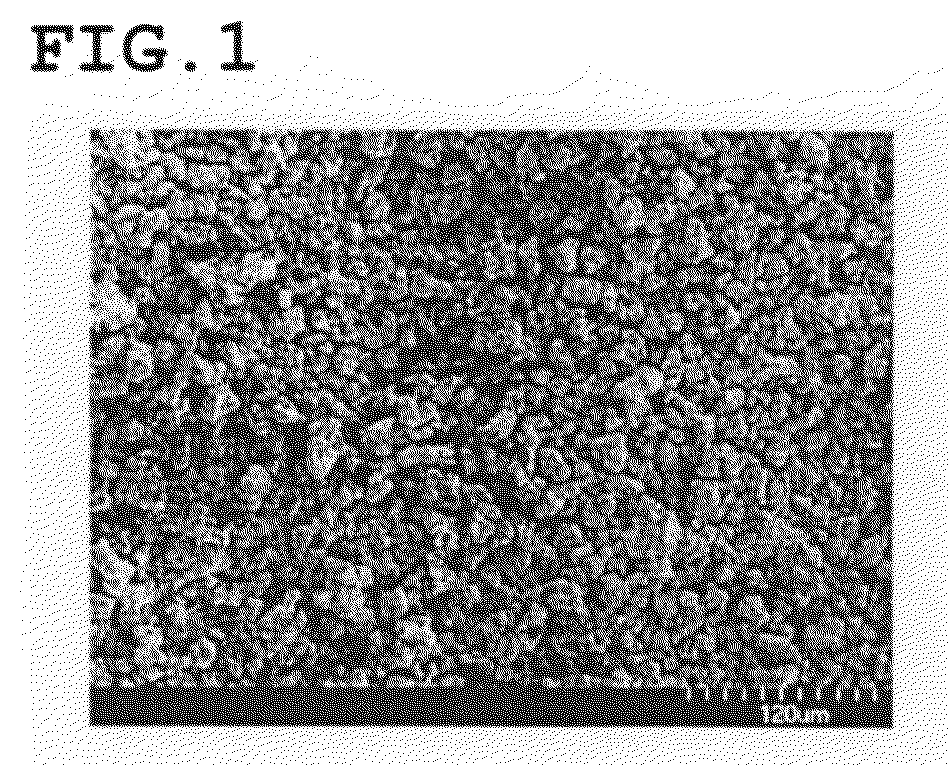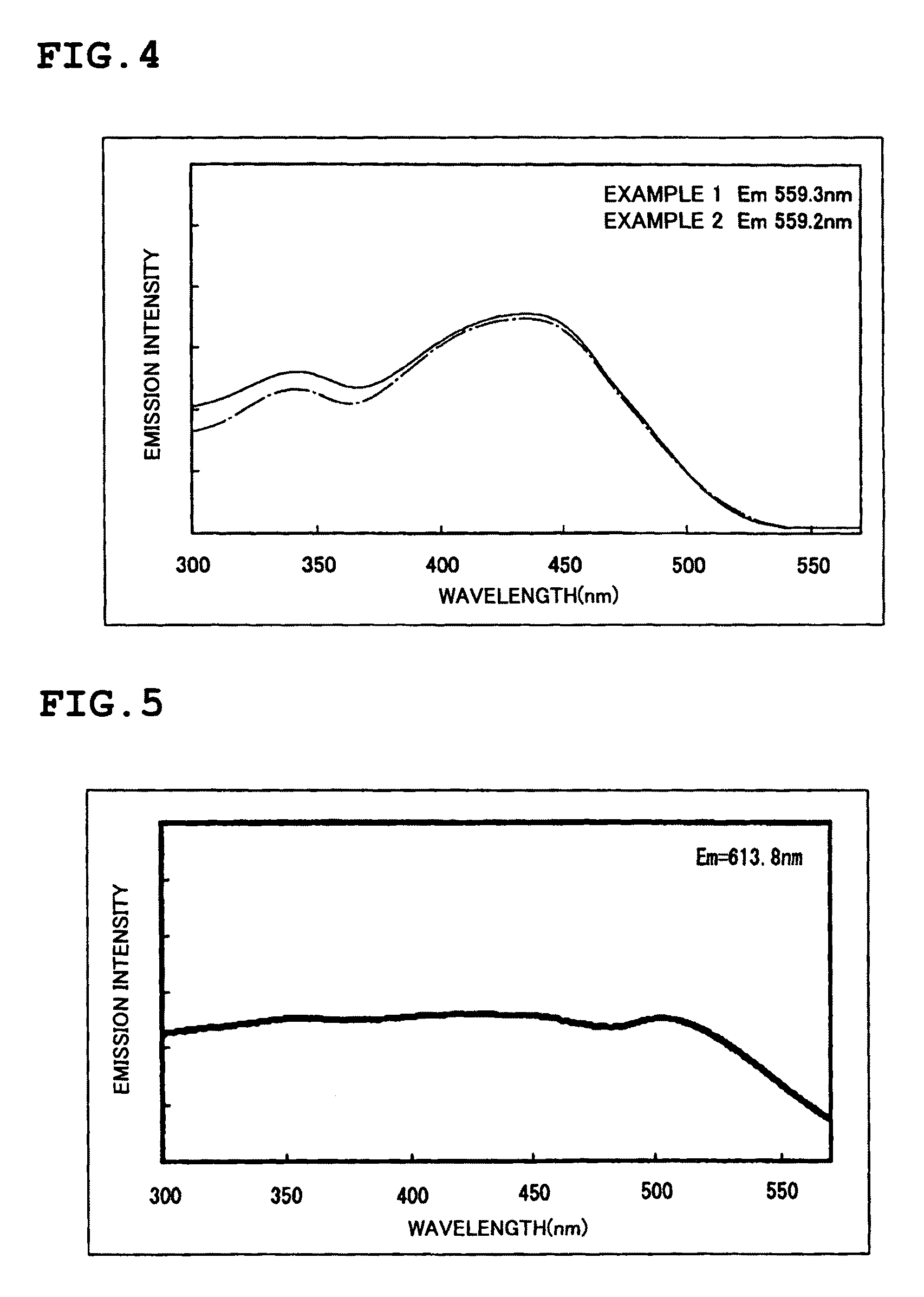Phosphor and manufacturing method therefore, and light emission device using the phosphor
a technology of light emission device and phosphor, which is applied in the direction of discharge tube/lamp details, discharge tube luminescnet screen, transportation and packaging, etc., can solve the problems of short life span, unsatisfactory color rendering properties of white light obtained, and deterioration of color rendering properties, etc., to improve emission intensity and luminance, improve the effect of durability against heat and water, and stable manufacture of white led illumination
- Summary
- Abstract
- Description
- Claims
- Application Information
AI Technical Summary
Benefits of technology
Problems solved by technology
Method used
Image
Examples
example
Example 1
[0205]Commercially available SrCO3(3N), AlN(3N), Si3N4(3N), and CeO2(3N) were prepared, and among the raw materials, 0.970 mol of SrCO3, 1.0 mol of AlN, 4.5 / 3 mol of Si3N4, and 0.030 mol of CeO2 were weighed and mixed by using a mortar in an atmospheric air. The raw material thus mixed was put in a BN crucible, then temperature is increased to 1800° C. with an in-furnace pressure of 0.05 MPa set at 15° C. / min, retained and fired at 1800° C. for three hours, and then cooled from 1800° C. to 200° C. for one hour. Thereafter, the firing sample thus fired was crushed to a proper particle size by using the mortar in the atmospheric air, and the phosphor of the example 1 of the composition formula expressed by Sr2Al2Si9O2N14:Ce (where Ce / (Sr+Ce)=0.030) was obtained. A result of a composition analysis of the powdery phosphor thus obtained is shown in table 1-2, and an SEM photograph of the powdery phosphor (250 times) is shown in FIG. 1.
[0206]The result of the composition analysis...
example 2
[0215]In the example 2, the phosphor of the example 2 is manufactured in the same way as the example 1, other than the molar ratio of each element of the example 1 is set at Sr:Al:Si:Ce=0.970:1:5:0.030.
[0216]The commercially available SrCO3(3N), AlN(3N), Si3N4(3N), CeO2(3N) were prepared, and each raw material was measured in 0.970 mol of SrCO3, 1.0 mol of AlN, 5.0 / 3 mol of Si3N4, and 0.030 mol of CeO2, so that the molar ratio of each element was set at Sr:Al:Si:Ce=0.970:1:5:0.030, and the raw materials thus measured was mixed in the atmosphere by using the mortar. The raw materials thus mixed was put in the crucible, and the temperature was increased to 1800° C. at 15° C. / min, with in-furnace pressure of 0.05 MPa, in a nitrogen atmosphere (flow state), and in this condition, the raw materials were retained and fired for 3 hours at 1800° C., then cooled from 1800° C. to 200° C. for 1 hour. Thereafter, a fired sample was pulverized in an atmospheric air to obtain a suitable particle ...
example 3
[0223]In the example 3, the phosphor of the example 3 was manufactured in the same way as the example 1, other than replacing Ce with Eu, as the activator, in the phosphor expressed by the composition formula Sr2Al2Si9O2N14:Ce (where Ce / (Sr+Ce)=0.030) of the phosphor of the example 1. The molar ratio of each element was expressed by Sr:Al:Si:Eu=0.970:1:4.5:0.030, and each raw material was measured in 0.970 mol of SrCO3, 1.0 mol of AlN, 4.5 / 3 mol of Si3N4, and 0.030 / 2 mol of Eu2O3. In the same way as the example 1, the analysis result of the powdery phosphor thus obtained is shown in table 1-2.
[0224]
TABLE 1-2AVERAGESPECIFICPARTICLESURFACECOMPOSITIONSrAlSiONCeEuOTHERSSIZEAREAFORMULA(wt %)(wt %)(wt %)(wt %)(wt %)(wt %)(wt %)(wt %)D50 (μm)(m2 / g)EXAMPLE 1Sr2Al2Si9O2N14:Ce24.87.0732.22.2530.51.231.9817.500.285EXAMPLE 2Sr3Al3Si15O3N23:Ce23.76.1133.62.1130.51.102.8816.850.302EXAMPLE 3Sr2Al2Si9O2N14:Eu24.57.1332.31.8328.11.324.8217.270.291
[0225]The analysis result of the composition of the p...
PUM
| Property | Measurement | Unit |
|---|---|---|
| molar ratio | aaaaa | aaaaa |
| molar ratio | aaaaa | aaaaa |
| wavelength | aaaaa | aaaaa |
Abstract
Description
Claims
Application Information
 Login to View More
Login to View More - R&D
- Intellectual Property
- Life Sciences
- Materials
- Tech Scout
- Unparalleled Data Quality
- Higher Quality Content
- 60% Fewer Hallucinations
Browse by: Latest US Patents, China's latest patents, Technical Efficacy Thesaurus, Application Domain, Technology Topic, Popular Technical Reports.
© 2025 PatSnap. All rights reserved.Legal|Privacy policy|Modern Slavery Act Transparency Statement|Sitemap|About US| Contact US: help@patsnap.com



